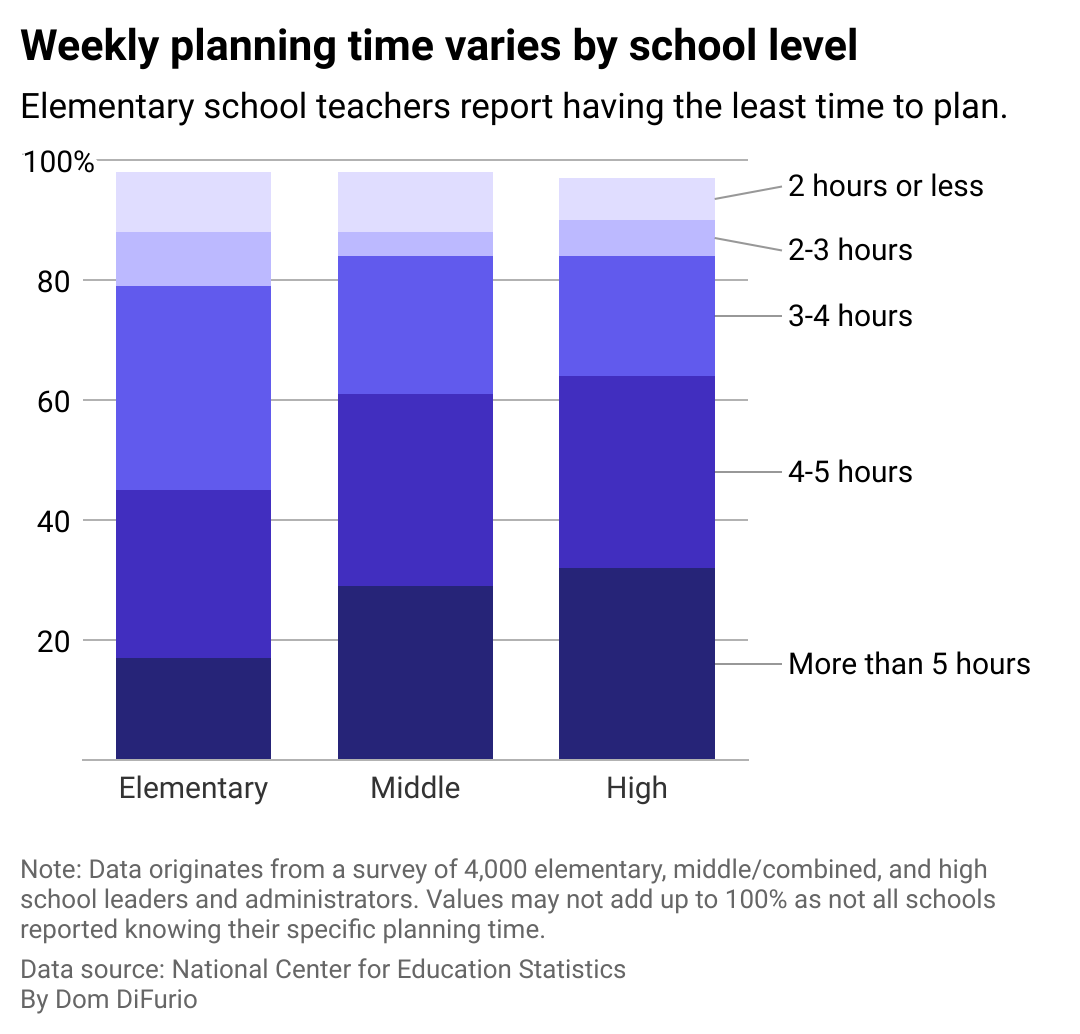Teachers are burnt out. The amount of time they get for planning might help explain why.

Canva
Teachers are burnt out. The amount of time they get for planning might help explain why.
An African American male teacher is looking at a paper in his left hand. He is holding a pencil in his right hand.
Teachers are the most burnt-out professionals in the country, and school districts nationwide are looking for ways to better support and retain them as increasing numbers of educators leave for retirement and other jobs.
HeyTutor analyzed National Center for Education Statistics data about teacher planning time to see which grade levels get the most time to work on lesson plans and other tasks each week. Planning time refers to the unstructured time outside of lecture and student interaction when teachers can review students’ progress and needs. They also use it to develop and plan curriculum and daily lessons, grade assignments, and meet with parents. In some states, minimum planning time is spelled out in state education codes.
Burnout occurs when teachers feel they’ve exhausted all of their personal and professional resources needed to perform their jobs, according to the National Education Association.
More than half (54%) of teachers report working “too many hours” outside the school day, according to a 2023 RAND survey. More compensation and improvements to working conditions are commonly cited by experts as necessary ways to increase teacher retention. As schools continue recovering from the learning loss incurred during the pandemic, planning time could also help teachers get ahead and go above and beyond simply being present in the classroom during instruction time.
Time to prep has also been shown to assist in teacher burnout, particularly with teachers of color as the industry works to attract and retain more diverse educators.
The COVID-19 pandemic greatly exacerbated student achievement gaps in areas like math and reading. To address this, experts are now urging school districts to take action, including tapping unused federal funding, to aid students in recovering from learning loss. That will require retaining talented educators and equipping them with the tools needed to help students catch up.
Earlier this year, Harvard Graduate School of Education professor and economist Thomas Kane emphasized in a Q&A with the university the importance of meeting with parents to discuss when a child is behind, something teachers can address during planning time if other tasks like administrative paperwork aren’t allowed to get in the way.
Teacher planning time varies between education levels. Throughout any given school day, they often have minutes—not hours—to do everything outside of managing the classroom and teaching their kids.
![]()

HeyTutor
Teachers most commonly have at least 3 to 4 hours of planning time each week
A bar chart showing the percentage of elementary, middle and high school teachers that receive a certain amount of planning time per week, based on a survey of public school administrators. Elementary teachers most commonly receive 3-5 per week, middle school teachers most commonly get 4-5, and high school teacher are most likely to have more than 5 hours per week or about an hour per day.
High school teachers are most likely to have five hours or more of planning time weekly, middle school teachers are more likely to have three to five hours per week (or less than an hour daily), and elementary teachers typically get even less time.
Elementary and middle school students in grades three through eight saw some of the steepest learning losses during the pandemic. A study from the Center for Education Policy Research at Harvard University released in 2024 found that learning loss on average equated to half a grade level in math achievement and a third in reading.
Teachers now face added pressure to bridge the pandemic learning gap. Many have to carefully manage the tension between spending more time with students to get them up to speed and guarding their much-needed planning time.
When teachers are given a say in their own working conditions, they prefer to have five hours or more per week for planning time. Unionized teachers in places like New York City have negotiated contracts that give member teachers minimum planning times of five class periods per week, though administrators can have them do other work during that time in emergency situations like filling in for a teacher absence elsewhere in the school.

Canva
Few schools report having increased planning time for teachers since 2019
An Asian female teacher holding her hands up while looking at the students in a classroom.
Just 28% of school administrators report having increased planning time for their teachers since 2019—prior to the pandemic—meaning a majority haven’t seen any change.
It may be a difficult concession for administrators to make given teacher turnover and a lack of qualified new applicants seeking to enter teaching positions, as well as fewer substitutes to fill in for them, has weighed on school systems around the country. In a majority of public schools, staffing is so thin that administrators are most often the ones to fill in when a substitute teacher can’t be found, not another teacher elsewhere in the school.
Among the 28% of teachers who reported they did receive increased planning time, nearly half of high school teachers added an hour or more, while large shares of middle and elementary school teachers increased their planning time by less than an hour.
One way educators have proposed creating more planning time for teachers is through increasing staffing in electives like the arts and physical activities. These allow teachers downtime while keeping students engaged throughout the school day.
School systems will need to solve more than just a lack of planning time to combat teacher burnout. Teachers also face large classroom sizes, low pay relative to the cost of living, clashes with parents, low funding that forces them to subsidize school budgets out of their own wallets, and student behavioral problems that can sometimes turn violent.
Some factors, like school funding and planning time, depend on larger forces like state legislatures and school administrators. However, the National Center for Youth Issues recommends several strategies for combating burnout that teachers can employ independently, including setting clear boundaries between work and personal time, getting regular exercise, leaning into hobbies, and taking regular vacations.
Story editing by Alizah Salario. Copy editing by Tim Bruns.
This story originally appeared on HeyTutor and was produced and
distributed in partnership with Stacker Studio.